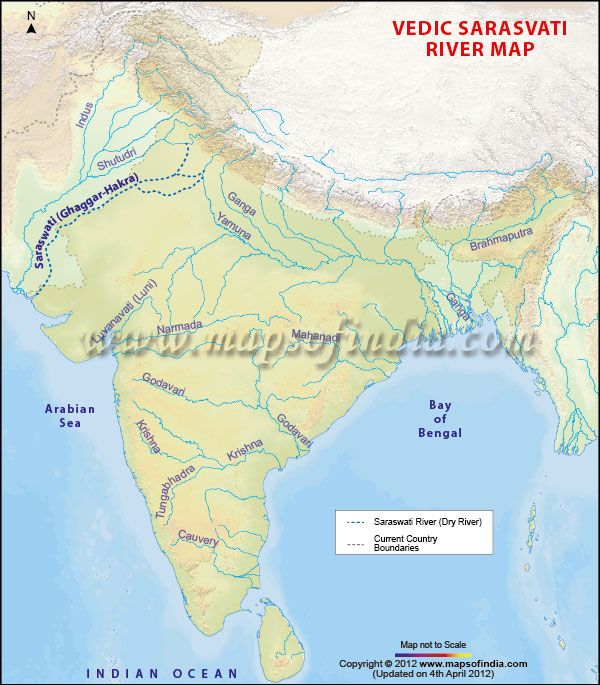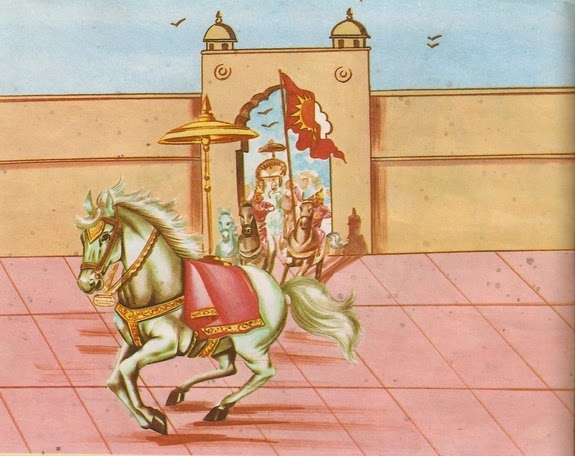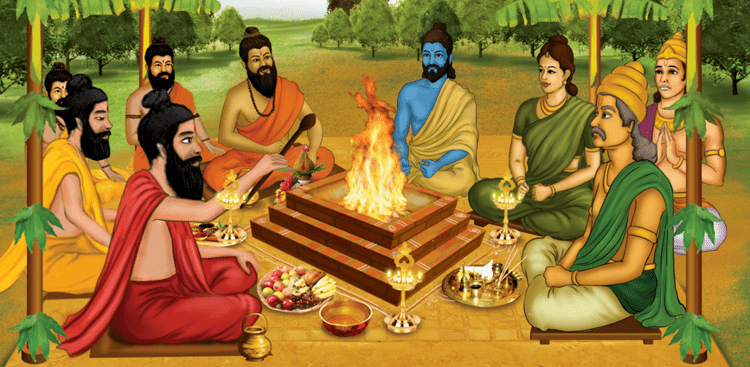Vedic Aryans are the first thing that flashed through our minds whenever the discussion is being initiated about either of Harappan Decline or the Rise of the Vedic age. Peoples from Vedic ages used to call themselves Aryans.
Geographical knowledge of Vedic Aryan (Early Vedic Age)
Early Vedic Age: The reference found in Rig-Veda Samhita help in understanding the geographical knowledge of the Early Vedic Age. The names of various rivers & other similar references helped in reconstructing the geographical spread of Early Vedic culture & geographical knowledge of Aryans.

After entering the Indian subcontinent the Vedic Aryans got settled into the Saint Saindhava region that is the land of seven streams. These 7 rivers were Indus, its 5 tributaries (Ravi, Beas, Sutlej, and Chenab & Jhelum) & river Saraswati. This reference indicates that the Vedic Aryan lived in Punjab and parts of Rajasthan
River Saraswati mentioned for the maximum number of times in Rigvedic Samhita (72). This indicates that Saraswati valley was a core region for Early Vedic Aryans. The river Yamuna mentioned only twice & Ganga is mentioned only once. This suggests that these rives were not significant in the life of the Early Vedic Age.
Brahmavarta region is mentioned as the geographical area of the Early Vedic Age. It was the land between the river Sutlej & Yamuna. Tiger is not mentioned in Rig-Veda. This suggests that the Early Vedic Age was yet to reach the forest of eastern India where tigers were found. Aryans aware of the Himalaya because they procured soma plants from the Mujvanta peak of the Himalaya.
Word “Samudra” mentioned in Rig-Veda Samhita. But it was used to refer to the huge amount of water seen in the northern plain of the river by Aryan. They were not aware of the Sea.
Geographical knowledge of Vedic Aryan (Later Vedic Age)
During the Later Vedic Age, Vedic culture moved into eastern India & they became aware of the entire Indian landmass. Satapatha Brahmana contains the story of the expansion of Vedic culture into the east. According to this book prince, Videgha Madhava accompanied by his priest Gautama Rahugana cleared the forest with the help of God fir. Fore got stopped after reaching Sadanira / Gandak (Bihar) & it was proclaimed that the area to the west of the river was suitable for the Vedic Age.
This reference suggests that Vedic Culture moved up to Bihar in the east during the Later Vedic Age. Atharvaveda contains references to tribes living in eastern Indra such as Anga (parts of Bihar) & Magadha. These references suggest that Vedic Aryans aware of entire eastern India. Eastern & Western seas are mentioned in Satapata Brahmana.
They suggest that Aryans were of the Bay of Bengal as well as the Arabian Sea. Southern mountain identified with Vindhyas Kaushataki Upanishad. Asteria Brahmana contained a reference of 5 fold geographical division of India. These 5 parts mentioned are Prachya (Eastern India), Pratichya (Western India), Uttarapatha (Northern India), Dhruva Madhya Mandis (Central India), and Tamilhama (Peninsular India).
Role of Iron in the life of Vedic Aryan
Vedic Aryans became aware of Aryan metallurgy around 1000 BC. Gradually the access to iron metal increased resulting in the use of iron for various purposes. The use of iron during the Later Vedic Age has been explained differently by different historians while some believed the use of iron was not very significant other believes that it was knowledge of iron metallurgy that changed life in the Later Vedic Age.
Early historians like R.S. Sharma believed that iron played a very important role in Agriculture progress during the Later Vedic Age. It was emphasized that iron axes were used for cleaning the forest & iron play share used for deeper plowing. It was this deeper plowing facilitated by the use of iron plowshare which enabled wet paddy cultivation. Expansion of agriculture through clearance of forest & wet paddy cultivation which agriculture production which in turn resulted in the attainment of a state of agriculture surplus. Availability of surplus prepared material foundation.
The recent researches carried out by historians like Nihar Ranjan Roy & D.C. Chakraborty have brought to light that role of iron in agriculture was in significance during the Later Vedic Age. Only one iron plowshare was discovered during an archaeological excavation at Jakhera (U.P). Such discoveries would have been frequent if iron plowshare was used commonly during the Later Vedic Age. Vedic Aryan used fire to clear forest as mentioned in Satpata Brahmana because hardly few iron axes were discovered during excavation.
The alluvial soil found in Gangetic Valley didn’t require iron plowshare for deeper plowshare. Ebony trees fond in Gangetic Vallies during the Vedic Age & plowshare of made of this hardwood used Later Vedic Age. Wet paddy cultivation was common practice in Western India for ages because, in the 6th millennium BC, people of Koldihava practiced wet paddy cultivation. This knowledge was adopted by Vedic Aryans from indigenous people once they moved to Eastern India.
Sacrifice – Yajna
It was an institution during the Vedic Age in which producers & non-producing sections of society participated. Sacrifices were performed by householders & the kings The householders performing sacrifice were mostly the peasant, merchant & traders & craftsman. Whenever a sacrifice was performed, the householder (Yajman) used to give fits to the priest conducting the sacrifice. This proc used to result in the exchange of resources between the producing class & non-producing class of priests.

Similar was the process involved when the king used to perform sacrifices. Since resources with the king were far greater when compared with common people, the king used to issue a huge amount of donation to the priestly class. As economic life evolved during the later Vedic Age & resource availability increased the size of sacrifice also underwent expansion.
Elaborate costly & complex sacrifices such as the Rajsuya sacrifice, Vajpayee & Ashwamedha sacrifice were the expansion of the same. The sacrifices like Vajpayee, Rajsuya & Ashwamedha were having political dimensions as well. Rajsuya sacrifice (coronation ceremony) enhanced the prestige of the crown. The Vajpayee was performed to increase the strength of the king. The Ashwamedha sacrifice was performed to carry out the territorial expansion.
The pattern of Society of Vedic Aryan
Settlement during Vedic Age: The literacy reference found in Vedic literacy & pieces of evidence gathered during archaeological excavation helped in understanding the character & pattern of human settlement during the Vedic Age. During the Early Vedic Age, life was essentially was ruler but during the Later Vedic, Age towns had emerged.
Some scholars like G.C. Pandey & G.S. Ghunya believe that Early Later Age also lived in towns. This opinion is based on reference found in Rigveda Samhita. Rig-Veda contains a reference to Chants & carts pulled by multiple horses. Such big vehicles require wide roads and the existence of wide roads in the Early Vedic Age also indicates that settlements were not villages having Narrow Street. Closer examination of reference related to economic life & settlements in Rig-Veda Samhita clearing revealed that Early Vedic Aryan lived in villages; their life was nomadic as they used to move from place to place.
During the Early Vedic Age, economics was pastoral, Aryan didn’t practice even agriculture. The pastoral life can’t support towns & cities. The suffixes like punar (resettlement) & Pra (Vis) indicate Ounar (Vis) that Early Vedic Aryan changed their settlement from time to time. During the Later Vedic, Age towns emerged in the area occupied by Vedic Aryans in form of political centers & commercial centers.
More than 30 settlement of the Later Vedic Age have been excavated so far much such settlement Ropar (Punjab), Nov (Rajasthan), Bhagvanpura (Haryana) Achichatra (Hastinapur-Mathura) & Atranjikhera (UP) has brought to light evidence of urban life. Archaeological pieces of evidence such as lapis lazuli, Chalcedony, Jasper, agate found from Later Vedic set indicate that Vedic Aryan was practicing Trade & Commerce with far of areas. These items were not naturally formed in the geographical areas occupied by Vedic Aryan.
Agates, Chalcedony were found in J & K, Gujarat & Madhya Pradesh. Lapis lazuli found in Badakshan Afghan. The Vedic Aryan lived in houses made in sum dried bricks, wood & grass, bamboos were used to make walls & roofs as revealed by pieces of evidence found at Ahichatra, Hastinapur Jakhera. At Bhagvanpura evidence of circular & rectangular huts has been designing. A 13 roomed house was found at Bhagvanpura. It was probably occupied by s
Archaeological excavation has also discovered painted graveyard ports used by Vedic Aryan during the Later Vedic Age wheel made. So far 42 designs of pottery have discovered dish & bowl common. The number of iron objects discovered during excavation. At Atranjikhera 135 iron objects have been found in form of arrowhead & spearhead.

